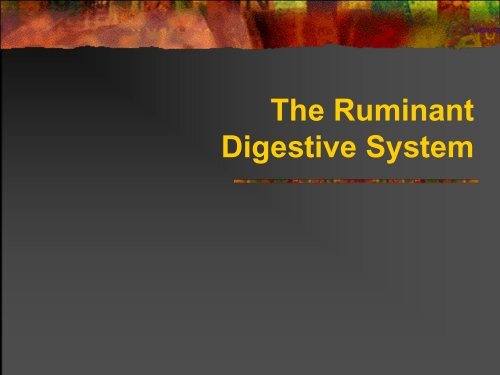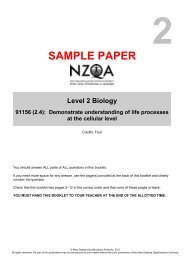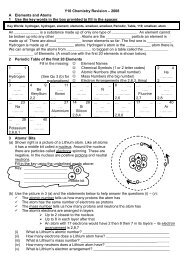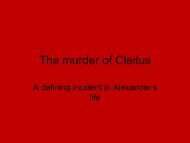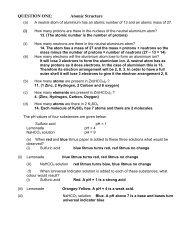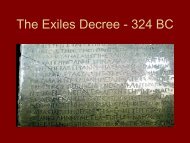You also want an ePaper? Increase the reach of your titles
YUMPU automatically turns print PDFs into web optimized ePapers that Google loves.
<strong>The</strong> <strong>Ruminant</strong><strong>Digestive</strong> <strong>System</strong>
<strong>Ruminant</strong> <strong>Digestive</strong> <strong>System</strong>s• Functions of the digestive system ofanimals include:• ingestion (eating)• chewing (mastication)• swallowing (deglutition)• absorption of nutrients• elimination of solid wastes (defecation)
<strong>Ruminant</strong> <strong>Digestive</strong> <strong>System</strong>s• <strong>The</strong> digestive system changes foodnutrients into compounds that are easilyabsorbed into the bloodstream.
<strong>Ruminant</strong> <strong>Digestive</strong> <strong>System</strong>s• Species like cattle, deer, sheep, horses,and rabbits that depend entirely on plantsfor food are classified as herbivores.• Animals like dogs and cats that dependalmost entirely on the flesh of otheranimals for food are classified ascarnivores.
<strong>Ruminant</strong> <strong>Digestive</strong> <strong>System</strong>s• Still others, like swine, birds, and humansthat consume both flesh and plants areclassified as omnivores.
<strong>Ruminant</strong> <strong>Digestive</strong> <strong>System</strong>s• Different species of animals havedigestive systems adapted to the mostefficient use of the food they consume.• <strong>The</strong> anatomy and physiology of thedigestive systems of herbivores,carnivores, and omnivores all differ.
<strong>Ruminant</strong> <strong>Digestive</strong> <strong>System</strong>s• <strong>Ruminant</strong>s are those animals that containa multi-chambered digestive system(polygastric) that allows the animal togain the majority of their nutritional needsfrom forages and other roughages.• Forage refers to grasses, roughagesrefers to other high-fiber food sources.
<strong>Ruminant</strong> <strong>Digestive</strong> <strong>System</strong>s• <strong>The</strong> digestive tract extends from the lips tothe anus. It includes the mouth, pharynx,esophagus, stomach, and the small andlarge intestines.• Accessory glands include the salivaryglands, the liver, and the pancreas.
<strong>Ruminant</strong> <strong>Digestive</strong> <strong>System</strong>s• <strong>The</strong> length and complexity of the digestivesystem depends on the species.• In herbivores, it is very long and complex.
RectumKidneyPancreasPharynx<strong>Ruminant</strong> Cecum <strong>Digestive</strong>Liver Esophagus<strong>System</strong>sTeethAnusPicture of digestive system of cowColonSmall IntestineRumenReticulumOmasumTongueSalivaryGlandAbomasum
<strong>Ruminant</strong> <strong>Digestive</strong> <strong>System</strong>s• <strong>The</strong> digestive system of ruminant animalsincludes the :• Mouth - grasps the food• Teeth - grind the food• <strong>Ruminant</strong>s have only one set of teeth in the front ofthe mouth (incisors), and two sets in the back(molars).
<strong>Ruminant</strong> <strong>Digestive</strong> <strong>System</strong>s• Tongue - covered with finger-like projections(papillae) that contain taste buds.• Salivary glands - secrete saliva, that moistensfood and is mixed with the food material to aidin swallowing.
<strong>Ruminant</strong> <strong>Digestive</strong> <strong>System</strong>s• Pharynx - funnels food into the esophagus,preventing food material from entering thelungs.• Esophagus - food tube that leads from themouth to the stomach.
Reticulum - full
<strong>Ruminant</strong> <strong>Digestive</strong> <strong>System</strong>s• <strong>Ruminant</strong> animals grasp mouthfuls of foodand swallow it before it is chewed.• <strong>The</strong>y wrap their tongue around a mouthful ofgrass, clamp down their teeth, and pull tobreak the grass at its weakest point, andswallow.
<strong>Ruminant</strong> <strong>Digestive</strong> <strong>System</strong>s• <strong>Ruminant</strong>s will“chew their cud” (regurgitate)their food material and then grind it with theirmolars at a time when the animal is resting.• This is done until the food particles are smallenough to pass through the reticulum into therumen.
<strong>Ruminant</strong> <strong>Digestive</strong> <strong>System</strong>s• Since ruminant animals do not “chew”their food when it is taken in, at timesforeign material like rocks, nails, smallpieces of wire, can be swallowed.
<strong>Ruminant</strong> <strong>Digestive</strong> <strong>System</strong>s• While the animal is “chewing its cud”foreign particles that are heavy are allowedto “sink” in the reticulum, preventing manyforeign particles from entering the rest ofthe digestive system.• Once foreign material enters the reticulum,it stays there for the life of the animal.
<strong>Ruminant</strong> <strong>Digestive</strong> <strong>System</strong>s• If enough of this foreign material remainsin the reticulum, it may cause damage andinfection of the reticulum (hardwaredisease).
Telephone Cord
Wire
Sponge takenfrom digestivesystem of ananimal
<strong>Ruminant</strong> <strong>Digestive</strong> <strong>System</strong>s• Rumen - the organ that allows for bacterialand chemical breakdown of fiber.• <strong>The</strong> rumen has a very thick, muscular wall.• It fills most of the left-side of the abdomen
<strong>Ruminant</strong> <strong>Digestive</strong> <strong>System</strong>s• <strong>The</strong> walls of the rumen contain papillae(that can be up to 1 cm. in length), wherethe bacteria that are used to breakdownfiber live.• In some ruminants (dairy cattle) the rumencan have a capacity of 55-65 gallons!
Papillae in Rumen
Papillae in Rumen
<strong>Ruminant</strong> <strong>Digestive</strong> <strong>System</strong>s• Omasum - section that is round andmuscular.• “Grinds” the food material and prepares thefood material for chemical breakdown.
Omasum - full
<strong>Ruminant</strong> <strong>Digestive</strong> <strong>System</strong>s• Abomasum - very similar to the stomach ofnon-ruminants.• this is where the majority of chemicalbreakdown of food material occurs.• mixes in digestive enzymes (pepsin,rennin, bile, etc.).
Abomasum – inside view
<strong>Ruminant</strong> <strong>Digestive</strong> <strong>System</strong>s• Small Intestine - where most of the foodmaterial is absorbed into the bloodstream• Contains three sections:•duodenum•jejunum•ileum
<strong>Ruminant</strong> <strong>Digestive</strong> <strong>System</strong>s• <strong>The</strong> food material is continuallysqueezed as it is moved through thesmall intestine, becoming more solid.• <strong>The</strong> majority of the food materialabsorption occurs in the duodenum andthe jejunum.
<strong>Ruminant</strong> <strong>Digestive</strong> <strong>System</strong>s• Large Intestine - begins to prepare unusedfood material for removal from the body• a portion of the large intestine in someanimals contain pouches that may containenzymes for further species-specificdigestion (horses and rabbits (cecum)).
<strong>Ruminant</strong> <strong>Digestive</strong> <strong>System</strong>s• In conclusion, the rumen allows forbacteria to breakdown fiber, enablingruminants to gain the proteins andenergy from plant sources.• Non-ruminant animals cannot obtain thenutritional value from most plantsources unless the food has beenmodified (ground, mashed, etc.)index


